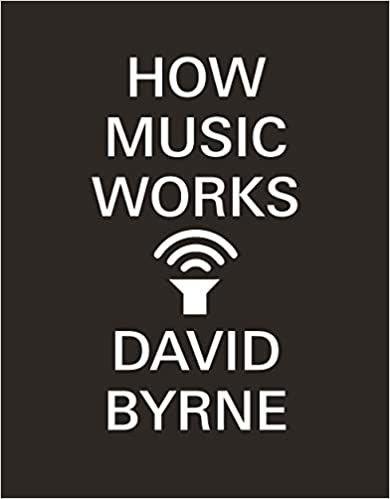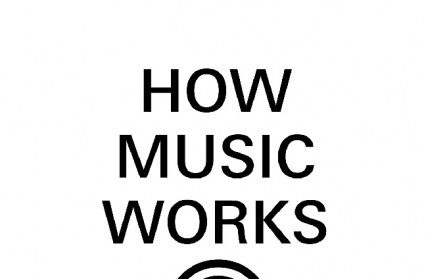Gary Raymond casts a critical eye over musical theory novel, How Music Works by David Byrne which explores the world of music theory.

Music is subjected to the most obsessive compartmentalising of all the art-forms – to the point of self-parody in many cases (Epic Doom-Metal, for instance). It has even reached the stage where the inability to categorise a musical artist has become something of a category in and of itself. David Byrne – singer, songwriter, conceptual artist, composer, innovator, inventor, instrument-builder, writer, performer, theoretician, curator – has always worked in ignorance of such restrictions. He states early on in his new book, How Music Works, that his initial career, and the one which made him famous – that of musician – was barely by design, and right up until his band, Talking Heads, released their first album he had little considered the possibility of a career in music. If Byrne is a highly knowledgeable musicologist, which this book testifies he is, then it is just another label to add to the umbrella definition of him: ‘artist’.
And so it is certainly a strength of this sumptuous book (few books have been met with such salivating approval in my neck of the woods as this beautifully designed coffee-table tome) that music is treated as a vast landscape, not unknown but still ripe for exploration, rather than a collection of categories. Byrne creates no friction when alluding to baroque, bebop and hip hop in the space of a few lines. It is an attitude established very early on, and it has two effects: the reader is immediately aware that this will be sweeping, a little unconventional, colourful, intense, enlightening, and extremely well-informed. It is, in all those ways, a David Byrne creation par excellence.
How Music Works begins with a chapter on Byrne’s own musical journey, but this book is not an autobiography. Although a little loose and insubstantial for anyone looking for a biography, or narrative on the life of Talking Heads, it is filled with little gems of information – such as the inspiration for his famous oversized suit for the Stop Making Sense tour being the costumes of Noh theatre. It serves as a perfect opening for the eclectic collection of chapters to follow. But it quickly becomes clear that Byrne is not exercising his ego by expounding memoir. Rather he is laying down his qualifications, picking through his own history to convince us that his arguments – non-confrontational but almost slightly jagged– are genuine.
Music is one sonic landscape, Byrne believes, containing many characteristics and fevered with (mainly human) symptoms. These symptoms are often societal. Byrne lays out a convincing structure for the development of music in relation to dance, for example, and also presents us with a fascinating insight into how nineteenth-century music developed with the conditioning imposed on it by the music halls for which it was written and in which it was played. Once the gentry had figured out a way to keep out the ‘noisy’ lower-classes the composers, for the first time presented with silent, attentive audiences, could incorporate soft, delicate movements to their music. Alongside this development the lower-classes retained their unappreciative manners in small bars and rowdy music halls, continuing to drink and chatter during performances. This forced musicians to play long and loud. And so brass was chosen over strings, banjos over acoustic guitars, and jazz, as we recognise it today, was formed. Improvisation was invented to lengthen the music, jamming over the central beams of the song, and so the party could go on as long as was needed.
The next most significant innovation in music turned this all back on itself – sound recording. The music of the lower classes could be quiet again and songs were compressed to fit the three-and-half minute format of a 45 record. Bix Beiderbeck, famously, complained throughout his career that he hated recording music due to time constraints. How could he say on one side of a record what, when playing live, he could take as long as was necessary to say?
It is perhaps when Byrne muses, waxes rhapsodic, in a muttering-to-himself kind of way, that the book really steps away from the fascinating narrative of the history of music and becomes something more. It is where Byrne’s passion for his subject becomes apparent (for Byrne’s prose is not the most passionate). When fighting with the idea that listening to one’s own recorded voice is always a strange experience, always a conflict between our internal perception and the distortions of perspective, he slides away to one side on a delightful and deceptively profound line of thought:
[Thomas Edison] implied that it was like looking into a mirror. But now I begin to wonder, do mirrors even really reflect us, or are they skewed and biased? Is the face we see while shaving or putting on makeup really us, or is it our ‘mirror self’, a self that – like audio recording – we have come to be familiar with, but in some ways is equally inaccurate?
It is this looseness that brightens everything. Byrne is not a scholar, but his celebrity and his body of work mean that his slackness in referencing the source of his arguments goes largely forgiven: so ‘David Attenborough and others have claimed…’ and ‘Scott Joplin said many times that…’ float lightly on the air, and the book, charmingly, begins to feel more like a fascinating conversation in a good pub than a lecture. Byrne, as a writer, joins the dots between the potential dryness of some of his sub-chapters, (‘Distribution Models’, ‘Bands Must Be Paid Fairly’), and the conversational style of his prose. His pen has a light touch, a simple style, minimalist, reminiscent of the early Talking Heads records, and it feels infused with his personality.
How Music Works could have been a biography, a lecture from an ageing rock star, and it could have been a curiosity. And although it is curious, it is not self-indulgent, even less is it a novelty item. What it is is a largely fascinating book – and fascinating from an array of different angles – written by a visionary, and for laymen. His assertion that vibrato is largely a fad born out of a long-forgotten necessity to be heard in a big band recording scenario may work as an unintentional dig at every screeching warbler who drunkenly toddles onto the X-Factor stage, but it is also important if slight, ingredient into the story of how we got to where we are now. He remembers Alan Lomax’s prediction that, as big corporations began to dice up the music industry for themselves, individuals would have their voices ‘smoothed out’. So whereas Lomax’s manufacturing of Leadbelly’s public persona as an overalls-clad illiterate black boy with a barely tuned guitar (Leadbelly was a dandy virtuoso in reality) now leaves a nasty taste in the mouth, Lomax was actually trying to introduce something that seemed authentic and fresh at the same time. As every young girl wanting to be a star adopts the heinous irrationalities of Christina Aguilera’s vocal style, searching for a melody like a moth searches for a light bulb, they are being exploited in a much more damaging way than Leadbelly was. And what’s worse: so are the audience. Skill is not in and of itself a valuable commodity, especially in art. It is still a skill to create useless ugly things. Aguilera is just one arbitrary example from the officer ranks of the conquering banshee hordes.
How Music Works is a coolly readable book, a large but swift and entertaining trawl through a seemingly random but connected series of topics. It could so easily have been called, What I Have Learned. Byrne has often been accused of taking himself too seriously – a completely unfair and now quite unfashionable opinion – although the inclusion of graphs and pie charts in the chapter ‘Business and Finances’ may set this back a few years. But the truth is that these sections are not dry or self-important in the slightest. Byrne is always playful, and his pie charts draw you in rather than warn you away. When he writes about the fluctuations in sales of musical formats, what could be a dry-as-dirt subject is not only flecked with an anecdote, quotes from a telephone interview with Warner Brothers Records former Chief Executive, Lenny Waronker, but he then punctuates it with a three-quarter page graph illustrating the Everest peak of CD sales toward the end of the nineties compared to the knolls of anything before or since. As with so many of Byrne’s projects, he has no hesitation in incorporating many techniques to prove his point. And there is always an engrossing outcome.
There are many alluring aspects to this book, then. It is a beautiful item, for one. For another, it is written by one of the most significant cultural artists of the post-punk world. Byrne is a master, one of the few figures to truly offer viable candidateship to the throne of David Bowie. And so the insights into the mechanisms of David Byrne – of which some large portions of the book are dedicated as a touchstone into wider debates about creative nature – are, of course, valuable. But, and perhaps more importantly, it is only a mind like that of Byrne who could draw lines between Schoenberg and Sun Ra, between Wagner and the Mississippi Sheiks and not sound pretentious, wild, or even over-reaching. Much of the faith needed in order to pull this off comes from what has proven Byrne’s most contentious asset: his personality. The book is very much a David Byrne project, and thus, it is just as ambitious, engrossing and vital as some of his best work.
How Music Works by David Byrne is available now.
Gary Raymond contributes regularly to Wales Arts Review.



 Enjoyed this article? Support our writers directly by buying them a coffee and clicking this link.
Enjoyed this article? Support our writers directly by buying them a coffee and clicking this link.







